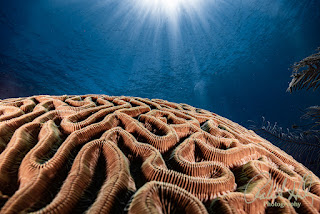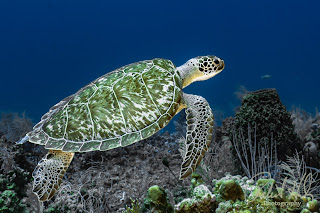Highlight vs Shadow Recovery in Lightroom Using AI Masks for Underwater Photography
🌊 Explore more tips at: info.robertherb.com/lm-2-blog
Have you ever come up for air after a dive and eagerly reviewed your underwater photos, only to find yourself thinking, "This shot had so much potential… if only I could manage the highlights or enhance the shadows"? If this resonates with you, you're certainly not in this alone. Underwater photography encompasses its own unique set of challenges, particularly when it comes to Exposure. Photographers often grapple with issues such as glaring sunbeams that wash out details and shadowy reef crevices that appear almost entirely black in images.
Fortunately, with the recent updates to Adobe Lightroom, specifically versions Classic 14.2 and Mobile, AI Masks are game-changing tools designed to tackle these common exposure dilemmas. These innovative features allow us to make adjustments with remarkable accuracy and efficiency. In the following post, I'll share my approach to utilizing AI-driven techniques for recovering highlights and shadows in underwater images through the use of selective masks. This method not only saves me a significant amount of time in my editing process but also ensures that the true essence and beauty of each underwater scene remain preserved, enhancing the overall impact of my photographs.
Why AI Masking Changes the Game Underwater
In the world of photo editing, particularly in Lightroom, traditional methods for adjusting global highlights and shadows can be effective, but they often come with significant limitations. These adjustments work like blunt instruments; when you increase brightness or reduce shadows, you risk altering the entire scene rather than targeting specific areas. This can lead to the unfortunate consequence of losing the sharpness of critical details that you may wish to preserve, resulting in a less-than-ideal image.
This is where the power of AI-driven masking tools comes into play, transforming the editing experience for photographers. Tools such as Select Subject, Select Background, and Select Objects leverage advanced machine learning technologies to automatically detect and isolate particular components within your photo. Whether you're trying to enhance the vibrant colors of a fish swimming among coral heads or manage the muted tones of a complex background filled with murky water, these innovative tools enable you to focus your highlight and shadow recovery techniques precisely where they're needed.
In essence, rather than applying broad adjustments that impact the entire image, these AI tools empower you to enhance your photographs strategically. You can elevate the visual appeal of your work without sacrificing the detail that makes a photo truly captivating, ensuring that each element of your composition maintains its integrity while shining brightly in its own right. This nuanced approach not only saves time but also significantly elevates the quality of the final output, making your editing process more efficient and effective.
Workflow Example #1: Blown-Out Highlights on Sunlit Divers
📸 Use case: Diver silhouette with overhead light beams
Step-by-step:
-
Open your image in the Develop Module
Shortcut:D -
Click on the Masking Tool
Shortcut:Shift + W -
Select "Select Subject"
Lightroom's AI will outline the diver. You can now adjust only the diver's exposure properties. -
Lower the Highlights to recover detail in the overexposed suit or tank.
Drag the Highlights slider to -50 or lower as needed. -
Optionally add a second mask: "Select Sky" (yes, Lightroom uses this for backgrounds - even underwater).
Reduce the Exposure slightly and add a touch of Dehaze (+5 to +10) for more beam definition.
Pro Tip: Use the K key to toggle the Brush Tool if you want to refine the mask manually around bubbles or light rays.
Workflow Example #2: Lifting Detail in Reef Shadows
📸 Use case: Macro shot with rich detail hidden in shadow
-
Create a New Mask → Select Subject to isolate your macro subject - say, a nudibranch.
-
Increase Shadows (+40 to +60) while watching for noise.
-
Add a Luminance Range Mask to target only the darker areas if the subject has mixed lighting.
Location: Inside the masking panel, click "Add" and choose Luminance Range
Shortcut: None, but it's next to Color Range. -
Inside the Luminance panel, drag the range handles to isolate the lower luminance (shadow) zones and increase Exposure slightly.
Efficiency Bonus: You just completed it in under 60 seconds, which used to take 10 minutes or more with radial filters and manual brushes.
Workflow Example #3: Balanced Wreck Shots with Harsh Contrast
📸 Use case: Wreck interiors with mixed strobe and ambient light
-
Use Select Object to click on specific elements like a school of fish or diver lights inside the wreck.
-
For each mask:
-
Decrease Highlights on reflective surfaces (e.g., tanks, sand patches)
-
Increase Shadows in hull interiors or behind objects for better balance
-
-
Fine-tune using the Tone Curve for contrast
-
Add a subtle S-curve
-
Shortcut:
Ctrl + 3(Windows) orCmd + 3(Mac) to open the Tone Curve Panel
-
Lightroom Mobile Workflow Tip
On the go? The Lightroom Mobile app (version 9.2 and newer) also supports AI Masks with incredible precision, even on a smartphone.
-
Tap the Masking icon.
-
Use "Select Subject" to isolate your coral or fish
-
Adjust highlights/shadows just as you would in Classic
I often do quick edits during surface intervals right from my tablet - AI makes it fast and accurate, even with limited screen real estate.
Time Saved, Details Preserved
In my older workflow, recovering highlight and shadow detail involved:
-
Creating multiple radial or linear gradients
-
Manually brushing around edges
-
Constantly toggling overlays for precision
Now? AI Masks automate 80% of that. I spend more time fine-tuning artistic vision and less time trying to "fix" problems. That's a win.
Keyboard Shortcuts Recap (Lightroom Classic)
| Action | Shortcut |
|---|---|
| Develop Module | D |
| Open Masking Panel | Shift + W |
| Brush Tool | K |
| Enable/Disable Mask Overlay | O |
| Reset Selected Slider | Double-click on the slider name |
Final Thoughts: Let AI Help, But Guide It
AI doesn't replace artistic intuition - it supercharges it. The key is understanding how to guide the AI. Don't settle for global sliders when you can paint with precision. Whether you're recovering the glowing armor of a parrotfish or unveiling hidden detail in a cave shot, Lightroom's AI masking system lets you target your edits with underwater precision.
Have you tried AI Masks in your underwater edits? Drop a comment or tag your edits using #RobertHerbPhotography.
Stay tuned for more AI-powered tips at info.robertherb.com/lm-2-blog, and remember - what you don't fix in your camera, Lightroom can now handle with ease.
Happy diving and editing,
– Bob Herb
Robert Herb Photography
📣 What's Your Experience with AI Masking?
Have you tried it on a recent dive trip? Got a before/after story to share? Tag me with your edits using #RobertHerbPhotography or drop a comment below.
📬Want More?
I'm creating an online training program specifically designed for underwater enthusiasts who want to refine their post-processing skills using Lightroom. Email me at bob@robertherb.com or visit the Training Page to join the early access list.
Follow my blog for weekly tips at Robert Herb Blog and share your edits with #RobertHerbPhotography—I'd love to see how you bring your images to life!
- 💡 Read more Lightroom tips and get weekly updates when new blogs are published at the Robert Herb Blog.
- 💡 Join my upcoming online training program – Learn to enhance your underwater shots with Adobe Lightroom! Sign up for a FREE "Before & After" Gallery.
- 💡 Share your processed photos on social media using #RobertHerbPhotography.
- 💡 Questions or want help with your Lightroom workflow? Email me at bob@robertherb.com
Written by Robert Herb – Empowering underwater photographers to capture and enhance the beauty of our oceans.
Stay tuned for more in-depth insights into underwater photography. Let's dive deeper into the art and craft of capturing the marine world! If you have any comments or suggestions, I'd love to hear them.
Get ready for an exciting underwater photography adventure! For more details on my upcoming online training course, check out my "Training" page at RobertHerb.com or email me at bob@robertherb.com.
Sincerely,
Bob Herb
|
|





Yes, I have used AI masks and agree that they are a game-changer. But every time I read one of your blog posts I learn something new and expand my understanding. Your posts are beautifully written and very helpful. Thank you for sharing your knowledge and experience in them. I truly look forward to working with you during my upcoming trip to Turquoise Bay on Roatán. -- Jesse
ReplyDelete